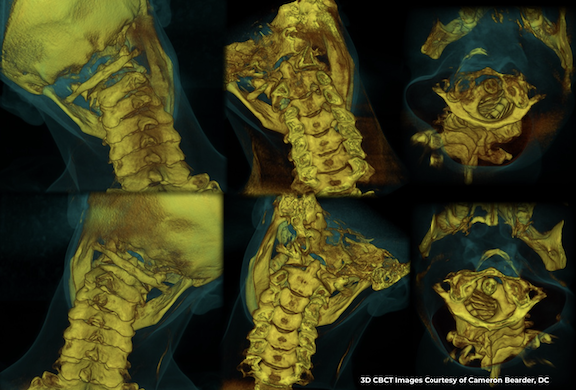Why Cone Beam Computed Tomography is Within the Scope of Chiropractic Practice
Written by: James Demetrious, DC, DABCO – Chiropractic Orthopedist
The following excerpt is from the White Paper I submitted to the North Carolina Board of Chiropractic Examiners (NCBCE), advocating for the inclusion of Cone Beam Computed Tomography (CBCT) within the scope of chiropractic practice. I am pleased to report that the NCBCE unanimously approved the use of CBCT in North Carolina.
For chiropractic physicians practicing in states where CBCT authorization has not yet been established, I welcome you to contact me directly for consultation and strategic guidance.
Abstract
Cone Beam Computed Tomography (CBCT) represents a revolutionary advancement in spinal imaging, offering three-dimensional visualization with significantly lower radiation exposure compared to conventional CT. This paper provides a detailed, evidence-based justification for the utilization, operation, and ownership of CBCT by chiropractic physicians in North Carolina. It highlights CBCT’s diagnostic benefits, scope alignment per the North Carolina General Statutes, and clinical appropriateness in managing cervical spine disorders such as ligamentous instability, hypomobility, and hypermobility.
1. Introduction
Cone Beam Computed Tomography (CBCT) has become increasingly relevant in chiropractic practice due to its ability to produce high-resolution 3D images of the bony structures of the cervical spine at a fraction of the radiation dose of traditional CT1,2. As the chiropractic profession advances toward precision-based care, tools like CBCT play an indispensable role in differential diagnosis, especially in evaluating upper cervical pathology, joint dysfunction, and ligamentous damage. 3,4
Recent literature supports the diagnostic accuracy and utility of CBCT for craniovertebral junction abnormalities, uncovertebral joint pathology, and degenerative changes. 5,6 The ability to visualize pathology in multiple planes and conduct weight-bearing or positional imaging further enhances its clinical value. 7,8
Conclusion
The advancement of Cone Beam Computed Tomography (CBCT) represents a transformative step forward in chiropractic diagnostics. Its unparalleled ability to produce high-resolution, three-dimensional images of the spine, particularly the upper cervical region, offers chiropractic physicians the precision necessary to deliver safe, informed, and effective care. CBCT aligns directly with the diagnostic and analytical methods permitted under NCGS § 90-151, and its use is consistent with the teachings, standards, and clinical demands of modern chiropractic practice.
Chiropractic physicians are increasingly relied upon to perform comprehensive neuromusculoskeletal evaluations and serve as primary spine care providers. As such, access to advanced imaging is not merely beneficial—it is essential. CBCT empowers practitioners to identify complex spinal pathologies, congenital anomalies, and segmental instabilities that may otherwise remain undetected by conventional radiographs. Moreover, its low radiation exposure, weight-bearing capabilities, and postural imaging options make it uniquely suited to chiropractic biomechanical analysis.
Numerous CCE-accredited institutions already incorporate CBCT into their clinical and academic programs, and national radiologic bodies, including the American College of Radiology and the European Society of Radiology, have acknowledged its value in musculoskeletal and spinal imaging. The precedent is clear: CBCT is an accepted and evolving standard of care within the broader healthcare landscape.
I respectfully urge the North Carolina Board of Chiropractic Examiners to affirm and support the utilization of CBCT by licensed chiropractic physicians. Doing so will not only maintain consistency with statutory and educational standards but also ensure that chiropractors in North Carolina are equipped with the tools necessary to deliver the highest standard of patient-centered care.
Such support reflects the Board’s ongoing commitment to advancing clinical excellence, fostering diagnostic precision, and protecting the health and safety of the people of North Carolina.

PostGradDC offers advanced post-graduate chiropractic continuing education. Our founder, Dr. James Demetrious, is a distinguished board-certified chiropractic orthopedist, educator, author, and editor.
Disclosure
The information provided in this article and all PostGradDC coursework should not be considered standards of care. We offer this information for educational purposes only. This information is not intended to be a substitute for professional medical advice, diagnosis, or treatment. Always seek the advice of your physician or qualified healthcare provider with any questions you may have regarding medical conditions or treatment. Seek the opinion of your legal representative.
© 2025 – James Demetrious, DC, DABCO. Open Access. Unrestricted use, distribution, and reproduction are allowed in any medium, provided you give appropriate credit by citing the original author and source: Demetrious J. PostGradDC. Why Cone Beam Computed Tomography is Within the Scope of Chiropractic Practice. PostGradDC.com; 2025.

